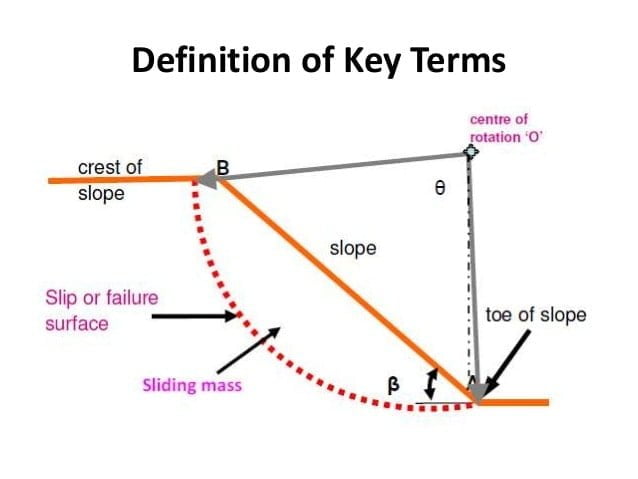Table of Contents
The slopes can be classified into two types namely, the infinite slopes and the finite slopes. An infinite slope is the type of slope that is very large in the extent to which the characteristics of the soil will remain the same at identical depths such that the slip surface will be a plane parallel to the surface of the slope.
On the other hand, a finite slope is the type of slope that is limited in the extent to which the properties of the soil will not be the same at the identical depths such that the slip surface will be a curve. Such slopes of the soil can undergo several failures due to the instability of the slopes.

Many of the slope failures are associated with the increasing amount of water ingress during heavy rainfall and flood.
1. Introduction
“The slope failure can be defined as the phenomenon in which the slope collapses abruptly as a result of the weakened self-retain ability of the soil usually due to rainfall, earthquake and other similar natural forces.”
2. Causes of Slope Failure
The slope failure can be caused by several human factors as well as natural factors. Some of the major causes of slope failure have been described in brief as follows:
1. Erosion
Erosion is the process of eroding the soil particles by natural forces such as wind, rainwater, etc.
The erosion of the soil is one of the major causes of slope failure and instability.
The water and wind cause the continuous eroding of the natural as well as the man-made slopes. Such erosion of the soil particles results in changes in the geometry of the slopes thereby failing slope.
In extreme conditions, it may also lead to a landslide. The flowing water of the streams and rivers also scour the banks and thus undermine the natural and man-made slopes leading to slope failure.
2. Rainfall
Another major cause of slope failure is rainfall.
Heavy rainfalls that occur for a subsequent period saturate and soften the soil making it more prone to erosion.
The rainwater also enters into the existing cracks and weakens the soil layers as a result of which the slope failure may occur.
3. Earthquakes
The seismic forces such as earthquakes are also the leading cause of slope failures and instabilities. Earthquake induces the dynamic forces in the soil particularly the dynamic shear forces. The induced forces then significantly reduce the shear strength and the stiffness of the soil making it more prone to failure. Usually, the failures of slopes during such seismic events occur under the un-drained condition.
4. Geological Characteristics
Some of the extreme or the difficult unidentified geological characteristics can cause the failure of slopes.
For example, a thin seam of few millimeters thick under a thick stiff clay deposit which can be overlooked during the drilling operations can be a potential cause of the slope failure.
Likewise, inappropriate assessing of the borehole logs can also fail slopes.
5. External Loading
The various types of load that are imposed on the top portion of the slope ( i.e. at crest ) add to the gravitational load and subsequently may lead to the slope failure.
The load placed at the toe of the slope is called a berm. It provides stability to the slope.
6. Construction Works & Operations
The various construction works and activities carried out near the toe of an existing slope eliminate the lateral resistance thereby causing the slope failure.
7. Rapid Drawdown
The slope failure in the case of the reservoirs may be subjected to rapid drawdown.
In such a case, the later water force is subsequently eliminated and thus the excess of the pore water pressure does not get sufficient time to dissipate.
Hence, the slope failure may occur under the un-drained condition.
If the failure under the un-drained condition does not occur then seepage of the groundwater may occur. Such seepage induces additional force resulting in slope failure.
3. Effects of Slope Failure
a. It causes landslides that may result in the loss of lives and properties.
b. It decreases the quality of soil nearby it.
c. Block and damage of road may occur due to slope failure.
4. Types of Slope Failure
In general, slope failure can be classified into the following four types:
1. Rotational Failure
It is the slope failure that occurs by the rotation along a slip surface usually by the downward and the outward movement of the soil mass.
Such type of rotational slip may be a base failure, a toe failure, or a slope failure.
Mostly, the slip surface is non-circular in the case of the non-homogenous soil and circular for the homogenous soil.
In the rotational failure, the failed surface moves outwards and downwards. The three ways by which the rotational failure may occur are further defined below:

a. Base Failure:
A rotational slip is said to be a base failure when the slip surface passes under the base of the slope.
It commonly occurs on a deep soft clay soil layer in which the failure surface passes below the toe.
It is also called deep-seated slope failure.
b. Toe Failure:
When the slip surface intersects the toe of the slope, it is called toe failure.
It is the most common failure.
c. Slope Failure:
A slope failure is a rotational failure that occurs when the sliding mass of the soil daylight is on the face of the slope.
It is also called face failure.
2. Translational Failure
It is the slope failure that occurs as a result of the movement of the soil mass along a level surface.
It is also commonly referred to as the translational slip.
This type of slope failure occurs in infinite slopes. The translational failure is commonly observed in the slopes of layered materials or natural formations.

Fig: Translational Failure
3. Compound Failure
As the name itself implies, it is the combination of translational failure and rotational failure.
The slope failure occurs along the compound failure surface.
The failure surface that is curved at the two ends and plane in the middle portion is known as the compound failure surface.
This type of slope failure commonly occurs when a hard stratum exists below the toe at a considerable depth.

Fig: Compound Failure
4. Wedge Failure
The wedge failure generally occurs along an infinite plane. It is also commonly referred to as block failure or plane slope failure.
The wedge failure generates a failure plane that is inclined.
Wedge failure mostly occurs when the wedges and the distinct blocks of the soil mass get separated.
It is also common when there are fissures, joints, or weak soil layers in the slope, or when a slope is made of two different materials.
The wedge failure is quite similar to a translational failure.
The only difference between the translational failure and the wedge failure is that translational failure only occurs in the case of infinite slopes but wedge failure can occur in both infinite and finite slopes.
The required criteria for wedge failure can be listed as follows:
a. The trend of the line of intersection should approximate the direction of dip of the face of the slope.
b. The angle of friction of the surface must be lesser than the plunge of the line of the intersection.
c. The dip of the face of the slope must be greater than the plunge of the line of intersection. The line of intersection in such conditions is referred to as the daylight on the slope.

Fig: Wedge Failure
5. Mitigation of Slope Failures
Some of the measures that can be adopted for the mitigation of the slope failures can be listed as follows:
1. Proper Drainage:
The provision of efficient drainage facilities can greatly reduce the possibility of any slope failure.
The common types of drainage systems that can be adopted are the French drains and the Weep holes.
2. Benching and Terracing:
Terracing and benching are the common effective methods used for the prevention of slope failure.
It has been found that the nearer a slope is to its natural angle of repose, the more stable it is.
Likewise, the methods of benching and terracing include the division of the slope into several small and less steep slopes that are duly retained by retaining walls and the friction piles.
3. Retaining Walls:
The retaining walls are extensively used to hold the soil mass thereby preventing slope failure.
4. Soldier Piles and Lagging works:
These are the mitigation measures that are mostly adopted for soft soils.
In this method, the piles are driven up to about two-thirds of their length into the slope towards the load-bearing strata.
5. Rock Bolts:
The rock bolts can be used to connect and hold the fractured or weak soil layers and rocks thereby increasing the slope stability.
6. Biotechnical Slope Stabilization:
Various biotechnical methods can be used for mitigating slope failures.
The biotechnical methods accomplish the stabilization utilizing vegetation.
This is because Vegetation is good for slope stability and planting different layers of vegetation on the slope is an effective way of stabilizing this slope.
| Read More: Ranging in Surveying |
| Read More: Surveyor Compass |

